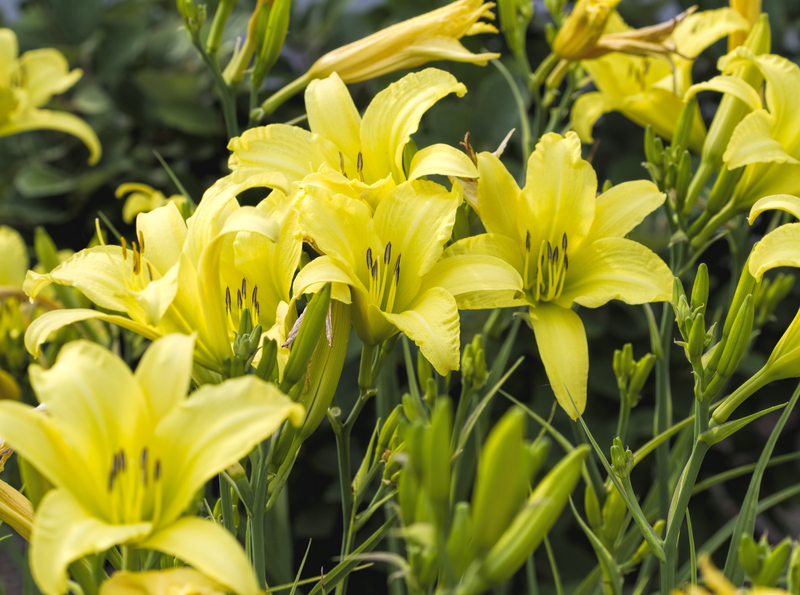Bring urban spaces to life with vertical gardens
Posted on 02/07/2025
Bring Urban Spaces to Life with Vertical Gardens: A Green Revolution
Urbanization has transformed city landscapes into bustling concrete jungles, often at the expense of greenery and biodiversity. However, an innovative trend--vertical gardens--is reversing the tide, infusing vibrant life into urban environments. Whether you call them living walls, green walls, or vertical green spaces, these installations promise more than just aesthetic value. They contribute to sustainability, improve air quality, and boost human well-being. In this article, we delve deep into how vertical gardens can revolutionize urban spaces, the benefits they offer, trends shaping their future, and practical tips for integrating them into our cities.

Understanding Vertical Gardens: What Are They?
Vertical gardens are structures designed to support plant growth on vertically suspended panels. Unlike traditional gardens that spread horizontally, these living green walls climb upward, transforming otherwise dull facades or unused urban surfaces into lush, thriving ecosystems. Made possible by hydroponic, soil-based, or modular planting systems, vertical gardens adapt to indoor or outdoor environments.
- Hydroponic systems: Use nutrient-rich water instead of soil.
- Soil-based systems: Employ specially-designed planters embedded with substrate.
- Modular panel systems: Allow interchangeable plant panels for creative patterns.
From small office lobbies to towering skyscrapers and public parks, these vertical green spaces are reshaping perceptions of urban landscaping worldwide.
Why Vertical Gardens Matter in Urban Areas
Integrating vertical gardens into urban spaces holds a myriad of advantages, both seen and unseen. Here's why cities worldwide are embracing this green revolution:
Enhancing Urban Aesthetics and Property Value
Vertical gardens instantly revitalize drab walls and neglected corners, lending color and life to otherwise monotonous concrete surfaces. The visual transformation can uplift community moods, making neighborhoods more attractive not only to residents but also to potential investors and visitors.
- Curb appeal: Green walls make commercial buildings and public spaces stand out.
- Increased property value: Enhanced aesthetics can boost real estate prices and rental appeal.
- Public pride: Unique green features foster a sense of communal identity and belonging.
Promoting Well-being and Mental Health
Scientific research consistently links increased exposure to nature with reduced stress, enhanced mood, and improved cognitive functioning. In dense urban settings, access to greenery can be limited. Bringing vertical gardens into urban environments ensures city dwellers experience these therapeutic benefits.
- Reduced stress: Views of living walls help lower cortisol levels and anxiety.
- Boosted concentration: Natural elements in workspaces enhance productivity and creativity.
- Healing environments: Hospitals use vertical gardens to accelerate patient recovery.
Combating Air and Noise Pollution
Air pollution is a pressing issue in metropolitan areas. Vertical gardens act as natural air filters, capturing dust, toxins, and carbon dioxide, while releasing life-enriching oxygen back into the atmosphere. In addition to their air-purifying qualities, vertical green walls also function as excellent sound barriers.
- Cleaner air: Plants absorb harmful pollutants such as nitrogen dioxide and particulate matter.
- Humidity regulation: Living walls increase moisture, making indoor and outdoor environments more comfortable.
- Noise reduction: Dense plant layers insulate buildings from urban noise.
Maximizing Space and Fostering Biodiversity
In cities where horizontal space is at a premium, vertical garden installations offer creative solutions for integrating greenery. They allow building owners and municipalities to maximize underused surfaces, such as blank side walls, fences, or even bus stops.
- Compact gardening: Vertical planting is ideal for small balconies and rooftops.
- Supporting urban wildlife: Green walls provide habitats for birds, butterflies, and beneficial insects.
- Urban farming potential: Edible vertical gardens produce herbs, vegetables, and fruits in city centers.
Energy Conservation and Building Efficiency
Installing vertical gardens on exterior and interior walls provides unique energy-saving benefits. Plants act as natural insulation, absorbing sunlight, reducing heat gain, and lowering indoor temperatures during hot months. In winter, they create a buffer that minimizes heat loss.
- Lower energy bills: Green walls mitigate the urban heat island effect, cutting down on air-conditioning use.
- Eco-friendly buildings: Living facades contribute to meeting green building certifications like LEED.
Innovative Applications of Vertical Gardens in Urban Spaces
The scope for incorporating vertical gardens in urban spaces is expanding rapidly, with inventive designs emerging across the globe. Here are a few inspiring examples:
- Public buildings: City halls, libraries, and hospitals use exterior green walls as both insulation and design statements.
- Commercial centers: Shopping malls and hotels embrace indoor vertical gardens for everything from lobby decor to restaurant dividers.
- Transport and infrastructure: Bus stops, metro stations, and highway sound barriers are being transformed into vertical plant havens.
- Residential towers: High-rise apartments integrate green balconies and shared living walls for communal gardening.
- Community initiatives: Local governments and NGOs install mobile green walls in schoolyards and parks to educate and beautify neighborhoods.
Case Study: The Iconic Bosco Verticale of Milan
One of the world's most renowned urban vertical garden projects, Bosco Verticale ("Vertical Forest") in Milan, Italy, showcases the possibilities of integrating greenery with high-density housing. These residential towers house over 900 trees, 5,000 shrubs, and 11,000 perennial plants within their vertical gardens, making the development a landmark in sustainable architecture and urban biodiversity.
Trend Watch: The Future of Vertical Gardens in Urban Planning
As cities strive to become more sustainable and resilient, vertical green spaces are taking center stage in urban planning. Here are some trends to watch:
- Smart technology integration: Automated irrigation, lighting, and environmental sensors are making living walls more sustainable and easier to maintain.
- Public-private partnerships: Joint ventures between businesses, property owners, and governments are leading to large-scale installations.
- Urban agriculture: The rise of edible walls for hyperlocal food production is gaining momentum, promoting food security.
- Improved plant selection: Advances in plant breeding and species selection are making vertical gardens more resilient to weather and pollution.
- Artistic expression: Designers and artists are using vertical gardens as a canvas, creating breathtaking living murals and inspirational public art.
How to Create a Vertical Garden in Urban Spaces
Interested in joining the movement and bringing urban spaces to life with vertical gardens? Whether you're a city planner, property owner, or enthusiastic gardener, here's how you can get started:
Step 1: Assess the Site and Purpose
- Identify a suitable wall--outdoor or indoor, bearing weight, and with access to sunlight or artificial light.
- Determine the main goal: beauty, increased privacy, insulation, or food production.
Step 2: Choose the Appropriate System
- DIY felt pocket systems: Perfect for smaller walls and home interiors.
- Modular planters: Ideal for flexibility and creative patterns.
- Hydroponic panels: Best for professional, large-scale installations.
Step 3: Carefully Select Plants
- Opt for low-maintenance, drought-tolerant species for sun-exposed walls.
- Incorporate a mix of textures, colors, and heights for visual appeal.
- Choose edible herbs or vegetables for an urban agriculture approach.
Step 4: Install Efficient Irrigation and Drainage
- Automated drip or hydroponic systems save water and ensure even moisture.
- Proper drainage prevents root rot and water damage to building surfaces.
Step 5: Regular Maintenance
- Prune and replant to keep your vertical garden vibrant and healthy.
- Monitor for pests, diseases, and nutrient deficiencies.
- Clean irrigation systems periodically.
Best Plants for Vertical Gardens
Plant selection is vital for a thriving, low-maintenance vertical garden. Consider these popular choices for urban vertical green walls:
- Ferns: Easy-to-grow, moisture-loving, and shade-tolerant.
- Pothos and philodendron: Ideal for indoor vertical gardens, air-purifying, and hardy.
- Succulents: Low-water needs, perfect for sun-exposed walls.
- Herbs (basil, mint, oregano): Fragrant, edible, and space-saving for urban farming.
- Spider plant and peace lily: Excellent air filters and adaptable to different light conditions.
- Native wildflowers: Attract pollinators and support urban biodiversity.

Potential Challenges and Solutions
While the concept of bringing urban spaces to life with vertical gardens is inspiring, it comes with a few challenges:
- Water management: Install efficient irrigation and drainage systems to avoid overwatering and leaks.
- Structural concerns: Ensure the supporting wall can bear the added weight and moisture of a living wall.
- Plant selection: Choose species suited to local climate and site-specific conditions to minimize maintenance.
- Initial cost: While installation can be pricey, numerous grants, tax credits, and incentives may offset expenses.
Conclusion: The Green Future of Urban Spaces with Vertical Gardens
The movement to bring urban spaces to life with vertical gardens is much more than a trend--it is a profound transformation in how we design and experience our everyday environments. By embracing living walls and vertical green spaces, cities can reduce their ecological footprint, enhance health and happiness, and reclaim the lost connection between people and nature.
From residential towers to highways, no surface is too small or insignificant to host a slice of greenery. As technology advances and the benefits become ever more apparent, vertical gardens will be at the heart of urban sustainability. Now is the perfect time to reimagine your city, street, or building--one vertical garden at a time.
Are you ready to join the urban green revolution?
```
